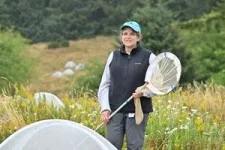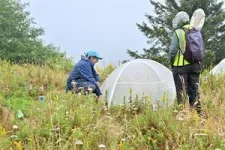(Press-News.org) VANCOUVER, Wash. – Some of the butterflies most in danger of fluttering out of existence fare better when their habitats are actively managed by humans, a recent study found.
A team led by Washington State University researchers Cheryl Schultz and Collin Edwards analyzed data on 114 populations of 31 butterfly species in 10 U.S. states. Scientists have long warned that insect populations worldwide are falling rapidly due to the combined effects of climate change, habitat loss and pesticides. Overall, the research team found that these at-risk butterflies are particularly vulnerable, with populations declining at an estimated rate of 8% a year, which translates to about a 50% drop over a decade.
The study findings, reported in the Journal of Applied Ecology, offer hope that habitat management can slow or even potentially reverse those sharp declines.
“The strongest signal we found is that in places where people are actively engaged with ways to manage the habitat, the butterflies are doing the best. That to me is super exciting because that means that habitat management can make a difference, even in the face of stressors like climate change,” said Cheryl Schultz, a WSU professor of conservation biology and co-lead author on the study.
With warmer temperatures brought by climate change, many butterflies have been shifting the timing of their seasonal activities, often by becoming active earlier in the year. It is an open question in ecology as to when shifts in timing are good, bad or relatively neutral for a species.
“We found that for these butterflies, big shifts in timing were generally bad. Populations with greater shifts were more likely to be declining,” said Edwards, a recent WSU postdoctoral fellow and co-lead author on the study. “However, we were excited to discover that habitat management appeared to be dampening the effect of climate change on butterfly timing. Populations that received more frequent management had smaller shifts in their timing.”
In spite of the overall negative population trends identified for these species, the links the research team found between population trends, shifts in timing and management provide a path forward for butterfly conservation.
“This might not solve the impact of climate change, but we can mediate some of the effects,” said co-author Elizabeth Crone, professor at University of California, Davis. “It’s within our power at the local level to do something positive for these populations.”
The study included species such as the Oregon silverspot, Taylor’s checkerspot, Karner blue and frosted elfin. It also included the Fender’s blue, which has become poster child for recovery efforts, after it bounded back from a few thousand butterflies in the 1990s to upwards of 30,000 today with the help of researchers like Schultz as well as public land managers and private landowners including many vineyards in the Willamette Valley.
In this study, researchers found that the type of habitat intervention selected by managers was appropriate, with activities such as prescribed burns, mowing, weeding and actively planting nectar or “host” plants for butterfly caterpillars, selected based on the needs of each area.
Volunteers can help in active management of local natural areas by assisting with new plantings and weeding out invasives, Schultz said. People can also support butterflies in their own backyard.
“We really encourage people to plant an abundance of wildflowers and plants which are both hosts for caterpillars and provide nectar for butterflies,” said Schultz. “These should be ‘clean plantings’ meaning they are pesticide free. The more we can reduce pesticides in our environment, the better it’s going to be for butterflies and insects.”
This research received funding from the U.S. Strategic Environmental Research and Development Program, the U.S. Fish and Wildlife Service and the U.S. Geological Survey.
END
At-risk butterflies more likely to survive with human help
2024-09-04
ELSE PRESS RELEASES FROM THIS DATE:
National Cleveland Clinic survey examines generational divide in men's health
2024-09-04
Embargoed until 12:01 a.m. Wednesday, September 4, 2024, CLEVELAND: A new national survey by Cleveland Clinic revealed similarities and differences across generations when it comes to men’s health. The survey highlights health priorities and concerns among men; however, there were generational differences in health habits, mental health and the use of social media as a source of health information.
While 95% of men surveyed said living a healthy lifestyle is their top priority, findings show that different health behaviors exist among ...
Sex and size disparities in access to liver transplant for patients with hepatocellular carcinoma
2024-09-04
About The Study: In this study, women with hepatocellular carcinoma were less likely to receive a deceased-donor liver transplant and more likely to die while wait-listed than men with hepatocellular carcinoma; these differences were largely (but not entirely) explained by sex-based differences in candidate size. For candidates listed with exception scores, additional changes to allocation policy are needed to resolve the sex disparity, including solutions to improve access to size-matched donor livers for smaller candidates.
Corresponding Author: To ...
The world's first nuclear clock
2024-09-04
For many years, scientists all around the world have been working towards this goal, now suddenly things are happening very fast: it was only in April that a team led by Prof Thorsten Schumm (TU Wien, Vienna) announced a major success. For the first time, an atomic nucleus had been switched from one state to another using a laser – an effect that can be used for high-precision measurements. Now, just a few weeks later, this thorium transition was successfully applied in practice: TU Wien and JILA/NIST (USA) succeeded in combining a high-precision optical atomic clock with ...
H5 influenza vaccines: what needs to be done to reduce the risk of a pandemic
2024-09-04
WASHINGTON — As the global threat of H5N1 influenza looms with outbreaks across species and continents including the U.S., three international vaccine and public health experts say it is time to fully resource and support a robust strategy to address this and future potential pandemic influenza threats, including to consider voluntary vaccination for those now at exposure risk.
“At this critical juncture, decisions about vaccine development, stockpiling, and deployment will shape our ability to respond to immediate and future pandemic risks,” write Jesse Goodman, MD, PhD; Rick A. Bright, PhD; and Nicole Lurie, MD, ...
Epigenetic changes reprogram astrocytes into brain stem cells
2024-09-04
Resting brain stem cells hardly differ from normal astrocytes, which support the nerve cells in the brain. How can almost identical cells perform such different functions? The key lies in the methylation of their genetic material, which endowes these special astrocytes with stem cell properties. Scientists from the German Cancer Research Center (DKFZ) and Heidelberg University have published their findings in the journal Nature. In mice, the researchers showed that experimentally induced lack of blood ...
Sex hormones modulate the immune system to influence disease risk differently
2024-09-04
Researchers have uncovered how hormones profoundly affect our immune systems, explaining why men and women are affected by diseases differently.
Scientists from the Karolinska Institutet in Sweden and Imperial College London have shown for the first time which aspects of our immune systems are regulated by sex hormones, and the impacts this has on disease risk and health outcomes in males and females.
It is well established that diseases can affect men and women differently, due to subtle differences ...
Researchers identify mechanism underlying allergic itching, and show it can be blocked
2024-09-04
Why do some people feel itchy after a mosquito bite or exposure to an allergen like dust or pollen, while others do not? A new study has pinpointed the reason for these differences, finding the pathway by which immune and nerve cells interact and lead to itching. The researchers, led by allergy and immunology specialists at Massachusetts General Hospital, a founding member of the Mass General Brigham healthcare system, then blocked this pathway in preclinical studies, suggesting a new treatment approach for allergies. The findings are published in Nature.
“Our research provides ...
Brain scanning approach shows wiring of depression
2024-09-04
By repeatedly scanning the brains of a small group of patients for a year and a half, Weill Cornell Medicine researchers have identified a distinct pattern of neuronal interactions that appears to predispose some people to developing depression.
Published Sept. 4 in Nature, the work highlights the potential of a new “deep scanning” approach to help predict a person’s susceptibility to depression and other neuropsychiatric conditions and may guide the development of novel treatments.
Neuroscientists have long relied on functional magnetic resonance imaging (fMRI) to identify patterns of activity ...
Heart drug improved exercise tolerance in clinical trial of patients with hypertrophic obstructive cardiomyopathy
2024-09-04
Exercise intolerance is often severe among patients with cardiovascular disease and can impose significant limitations on their physical abilities and quality of life. Medications known as cardiac myosin inhibitors (CMIs) are being developed to help patients with hypertrophic obstructive cardiomyopathy (HOCM), a disease in which the heart muscle becomes thickened leading to reduced blood flow out of the heart. In a new analysis led by researchers from Mass General Brigham, investigators probed multiple exercise response ...
Menstrual cycle influences the spread of mutant cells in mammary tissue
2024-09-04
Leuven/Amsterdam/Cambridge, 5 September– A team of researchers at the VIB-KU Leuven Center for Cancer Biology, the Netherlands Cancer Institute and Oncode Institute and the University of Cambridge have discovered that a defensive mechanism connected to the menstrual cycle plays a role in spreading mutant cells within mammary tissue. A new study published in Nature describes how the growth and subsequent removal of extra milk ducts in breast tissue during the menstrual cycle can contribute to the spread of mutant cells leading to large mutant fields prone to develop tumors.
Although tissue in healthy individuals may look completely normal, ...



